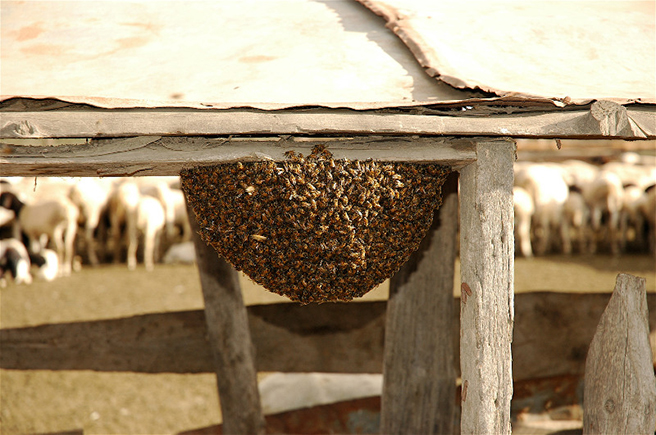Beehive Fences Reduce Human-Elephant Conflict

The old saw from Looney Tunes and similarly informed sources has it that African elephants—the mightiest land mammals on Earth which historically were unafraid to charge legions of Roman troops at the nod of their Carthaginian handlers—are for some reason deathly afraid of mice.
The sudden appearance of tiny house mice in those vintage animated shorts would cause monumental Loxodonta africana to bellow in terror and rear up on its hind legs like a Victorian lady confronting a puff adder. Perhaps this upending of ecological reality was meant to demonstrate to impressionable kids the underlying cowardice of big bad bullies, but the premise remains disarmingly inane: why would something so huge fear something so minute?
Yet the elephant/mouse myth isn’t wholly without a real-world analogy, and the ability of animals much smaller than even mice to repel elephants from demarcated agrarian areas promises to sharply reduce human/wildlife conflicts that can contribute to poaching.
Lucy King is with the British nonprofit Save the Elephants, and she recently told the online journal SciDevNet that her organization, in collaboration with Oxford University and the Disney Worldwide Conservation Fund, is installing “beehive fences” around farms in Botswana, Mozambique, Tanzania and Uganda. As with most good ideas the premise is startlingly simple: wire fences are erected around farm plots bordering nature reserves and parks where human populations have increased and elephants are causing depredations among vegetable and row crops. Beehives, interconnected by wires, are placed every 30 feet along the fence. When the elephants come swaggering up to knock down the fence and raid the crops, the line’s entire insect population swarms to the attack. In a 2011 pilot study King spearheaded, 17 Turkana farms in northern Kenya found 1,700 meters of beehive fencing to be a superior deterrent when compared with traditional thorn bush barriers, with 13 of 14 elephant raids deterred. The 106 kg of honey later gathered by the farmers only sweetened the deal.
This is all abundantly sensible. Elephants certainly have thick skin but they’re not armored like rhinos, and their browsing habit of reaching far up into trees to pull down choice leaves and branches puts them very much on the path to confrontation with Africa’s notoriously irritable honeybees (Apis mellifera scutellata). In fact, according to Lucy King, it was learned over ten years ago that elephants actively avoid feeding on trees housing beehives. “This was followed by behavioral experiments demonstrating that not only do elephants run from bee sounds, but they also have an alarm call that alerts family members to retreat from a possible bee threat,” King told SciDevNet. For elephant society to have developed a specific warning sound to steer clan members around active hives seems to speak to the seriousness with which these giants view the threat of bee stings.
Human encroachment into wildlife habitat, impelled by unsustainable population growth and the exhaustion of soil from poor farming practices, is at the root of human/wildlife conflict in Africa, and local governments must provide direct incentives to keep farming communities from infringing on protected areas and thus sparking clashes with elephants, rhinos, lions and other native wildlife. Effective buffers between human activity and designated wilderness areas would eradicate much of the negative human/wildlife interaction we are now witnessing, but where agriculture and wildlife are already cheek by jowl, innovative deterrence methods including bee fences, dogs, firecrackers and drums can be successfully resorted to in efforts to protect crops, thus eliminating the need for poisons, snares and rifles.
In rural Africa, where solar-powered electric fencing is scarce and thorny barriers often ineffective, beehive fences make good neighbors, and not just for hardworking farmers but, ultimately, for their toothy countrymen as well. Hungry elephants may be unpleasantly dissuaded from snacking on fresh melons, but with the stigma of economic competition removed, their long-term survival has received a hopeful boost indeed.